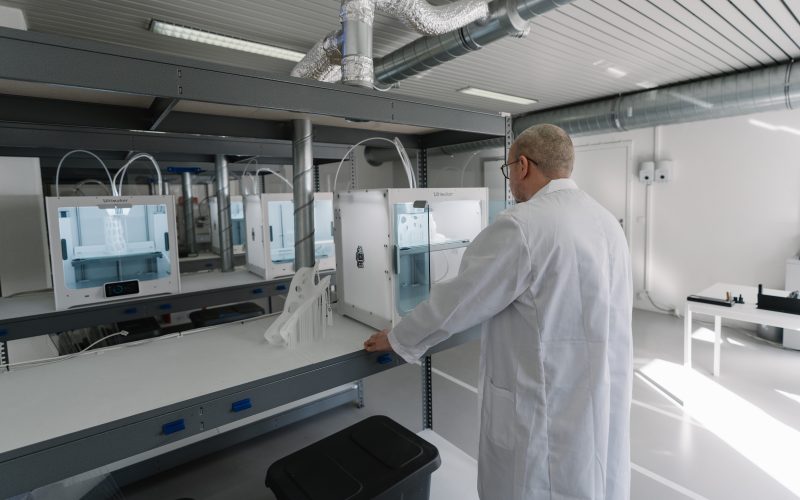The ever-evolving realm of 3D printing has brought about groundbreaking possibilities across various industries, and the medical field is no exception. Additive manufacturing technologies have paved the way for more efficient, tailored, and cost-effective solutions to address the multitude of challenges faced by healthcare professionals. Among these technologies, stereolithography (SLA) stands out as a promising avenue for revolutionising medical device development and patient care. This article delves into the multitude of benefits offered by SLA 3D printing and explores its key applications within the medical industry.
Advantages of Stereolithography in Medical 3D Printing Around the world, the medical industry is embracing 3D printing as an innovative tool to propel progress. The adoption of this technology has been driven by the desire to enhance patient care and outcomes, streamline surgical procedures, and expedite product development cycles. Stereolithography (SLA), one of the oldest and most widely used industrial 3D printing methods, utilises a high-powered laser to selectively cure photosensitive resin layer-by-layer. It offers several benefits that are particularly well-suited for medical 3D printing:
Precision: With an impressive tolerance capability of ±0.10-0.15mm, SLA ranks among the most precise 3D printing methods available, ensuring dimensionally accurate parts – an essential aspect for patient-specific devices.
Detail: The high resolution of SLA 3D printing enables the creation of intricate and complex structures with a smooth surface finish, allowing for an unprecedented level of detail.
Versatility: SLA 3D printing is compatible with a wide range of materials, including various biocompatible and sterilisable resins that are suitable for critical medical applications.
Efficiency: By expediting prototyping and shortening production cycles, SLA fosters efficiency in product development, leading to faster delivery of innovative medical devices and ultimately improving patient care.
Furthermore, SLA eliminates the need for costly tooling, providing a more cost-effective solution for prototyping and low-volume production. This reduction in financial burden contributes to increased accessibility to medical care.
Applications of SLA 3D Printing in Healthcare The numerous advantages of SLA 3D printing, combined with its cost-effectiveness, have resulted in a plethora of applications within the medical industry. These applications span various domains, highlighting the technology’s versatility and potential for innovation. Let’s explore five notable examples:
- Anatomical Models for Surgical Preparation: 3D printing enables the production of patient-specific anatomical models based on CT scans or MRI data. These models serve as tactile and visual aids for surgeons, facilitating pre-surgical planning and intraoperative guidance. SLA’s exceptional accuracy allows for the creation of precise and detailed replicas of a patient’s unique anatomy, thereby improving surgical outcomes.
- Patient-Specific Medical Devices: SLA empowers the development of customised medical devices, prosthetics, and implants tailored to individual patients’ needs and anatomy. This customisation enhances functionality, durability, and comfort. For example, 3D printed hearing aids can be precisely shaped to fit an individual’s ear canal, ensuring optimal performance and patient satisfaction. SLA’s ability to produce parts using diverse materials with excellent properties, such as flexibility, transparency, toughness, and biocompatibility, lends itself to a wide array of medical devices, including dental aligners and finger splints.
- Surgical Instruments: SLA 3D printing finds application in the production of surgical instruments like guides, forceps, clamps, and cutting tools. These tailor-made instruments assist surgeons in performing precise and complex surgical procedures. For instance, a customised surgical guide can facilitate accurate screw placement during orthopedic surgery. The high-resolution capabilities of SLA enable the creation of detailed and intricate surgical instruments, reducing risks and enhancing the success of operations.
- Emergency Medical Supplies: In critical situations and times of crisis, the speed and efficiency of SLA 3D printing can be lifesaving. SLA can swiftly produce essential medical supplies, such as Personal Protective Equipment (PPE) and virus testing swabs. This capability proves invaluable during pandemics and armed conflicts, where traditional supply chains may face disruptions while the demand for these supplies remains high. An example of this is Glia, a Canadian company that has developed 3D printed tourniquets to save lives in Ukraine.
- Rapid Prototyping for Clinical Trials: SLA printing’s fast turnaround times greatly benefit medical research and development, particularly in terms of rapid prototyping. It allows for accelerated design iterations of new medical devices, manufacturing tools, training instruments, and more. This expedites the transition from the conceptual stage to clinical trials, significantly reducing time-to-market for medical innovations and potentially saving lives in the process.
In conclusion, stereolithography plays a pivotal role in shaping the future of the medical industry, with diverse applications across various healthcare domains. As 3D printing technology continues to advance, its scope will expand further, enhancing precision, personalisation, and efficiency in medical services for patients both in the UK and beyond. For more information on our SLA 3D printing service, contact LPE today.









